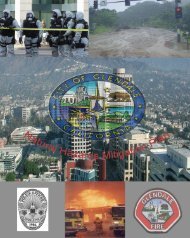Sayre Report - Hazard Mitigation Web Portal - State of California
Sayre Report - Hazard Mitigation Web Portal - State of California
Sayre Report - Hazard Mitigation Web Portal - State of California
You also want an ePaper? Increase the reach of your titles
YUMPU automatically turns print PDFs into web optimized ePapers that Google loves.
tests ranged from low to moderate with small patches <strong>of</strong> high confirming the burn<br />
severity map. The soils in the <strong>Sayre</strong> Fire are in the loam category and have a<br />
moderately high susceptibility to erosion and will produce moderate sediment flows.<br />
Evaluations <strong>of</strong> the Los Angeles County Public Works Debris Basins indicate some initial<br />
signs <strong>of</strong> increased sediment load. The access road at the Pacoima Reservoir was<br />
reported to have had up to 3 feet <strong>of</strong> erosion sediment blocking the main access to the<br />
Dam. The box culvert under Gavina Avenue was observed to have up to two-feet <strong>of</strong><br />
sediment, but could easily become completely blocked. Multiple residential debris<br />
basins and small drainage areas behind a number <strong>of</strong> homes were evaluated with minor<br />
to no erosion sediment observed from recent storm events.<br />
Mulching, fiber rolls, and straw bales with silt fencing may be used to prevent erosion at<br />
high value sites or to prevent run<strong>of</strong>f damage to specific roads or site improvements.<br />
Timely maintenance after storm events on road drainage crossings, culverts, and catch<br />
basins can help keep access open and homes safe. it is recommended that signs be<br />
posted to deter activities that would increase erosion damage. Road access could also<br />
be limited by maintaining locked gates at entrance points to major roads.<br />
Water Quality<br />
Areas <strong>of</strong> concern are residential areas immediately downstream <strong>of</strong> the burned area,<br />
especially below culverts and drainages. The values at risk are: possible loss <strong>of</strong> life and<br />
property due to flooding caused by blockages, debris flows, slope- and water-generated<br />
landslides, rock fall, associated hazards, and impacts to water quality.<br />
The Oakridge Mobile Home Park, which is located at the base <strong>of</strong> the foothills in Sylmar,<br />
<strong>California</strong>, consumed approximately 480 mobile homes in a catastrophic fire event. It is<br />
assumed that because the structures were lost, are on a slope, and that burned manmade<br />
materials remain, the potential for these materials to be mobilized is increased<br />
during a rain event. If that is the case, there is potential for impact to waters <strong>of</strong> the state<br />
or U.S. If the drainage from Oakridge (if the burned materials remain) is not diverted,<br />
contained, or sent to a water treatment facility. It is also expected that increased<br />
turbidity downstream will occur as a result <strong>of</strong> increase in sediment and debris coming<br />
from the burned <strong>Sayre</strong> Fire area.<br />
Structural Engineering<br />
Multiple residential structures were damaged or destroyed by the <strong>Sayre</strong> Fire. Seven key<br />
infrastructure debris basins need remediation, one county agency bridge needs repair,<br />
one equipment shed was destroyed, numerous Metal Beam Guard Railing (MBGR)<br />
timber posts along Fwy. 210 North and South bound Connector to Interstate 5 do<br />
require replacement. Four major bridge structures (Glenoaks, Yarnell, and Fwy 210<br />
North and South bound to Interstate 5) close to the vicinity <strong>of</strong> the fire area have not<br />
suffered any structure damage.

















